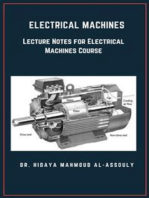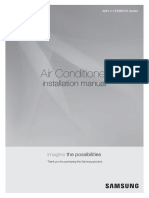Module 5 Electrical
Uploaded by
SKANDAN BHARADWAJModule 5 Electrical
Uploaded by
SKANDAN BHARADWAJIEE-Module 5
UNIT V
SPECIAL MACHINES, ELECTRICAL WIRING AND SAFETY
5.1 Construction and working principle of BLDC Motor and Stepper Motor and their
applications
5.2 Introduction to domestic wiring, Fuse, MCB, ELCB and Relay.
5.3 Necessity of earthing, difference between earthing and grounding and types of grounding.
5.4 Electric shocks, hazards and safety precautions.
5.5 Standards of wiring as per BIS
5.1 Construction and working principle of BLDC Motor and Stepper
Motor and their applications
Construction
BLDC motors are a type of synchronous motors. This means the magnetic field generated by the
stator and the magnetic field generated by the rotor rotates at the same frequency. BLDC motors
do not experience the “slip” that is normally seen in induction motors. BLDC motors come in
single-phase, 2-phase and3-phase configurations. Corresponding to its type, the stator has the
same number of windings. Out of these,3-phase motors are the most popular and widely used.
(a) (b)
Figure. Construction of a BLDC motor (a) front view (b) transverse sectional view
Dept. of EEE, NIE College Mysuru Page 1
IEE-Module 5
Stator
Stator of a BLDC motor made up of stacked steel laminations to carry the windings. These
windings are placed in slots which are axially cut along the inner periphery of the stator. These
windings can be arranged in either star or delta. However, most BLDC motors have three phase
star connected stator. Each winding is constructed with numerous interconnected coils, where
one or more coils are placed in each slot. In order to form an even number of poles, each of
these windings is distributed over the stator periphery.
Rotor
The rotor is made of permanent magnet and can vary from two to eight pole pairs with alternate
North (N) and South (S) poles. Based on the required magnetic field density in the rotor, the
proper magnetic material is chosen to make the rotor. Ferrite magnets are traditionally used to
make permanent magnets. Rare earth alloys are also being used now-a-days for making the
permanent magnets.
Hall Sensors
Unlike a brushed DC motor, the commutation of a BLDC motor is controlled electronically. To
rotate the BLDC motor, the stator windings should be energized in a sequence. It is important to
know the rotor position in order to understand which winding will be energized following the
energizing sequence. Rotor position is sensed using Hall effect sensors embedded into the
stator.
The Hall sensors are normally mounted on a PC board and fixed to the enclosure cap on the
non-driving end. This enables users to adjust the complete assembly of Hall sensors, to align
with the rotor magnets, in order to achieve the best performance. Based on the physical position
of the Hall sensors, there are two versions of output. The Hall sensors maybe at 60° or 120°
phase shift to each other. Based on this, the motor manufacturer defines the commutation
sequence, which should be followed when controlling the motor.
Dept. of EEE, NIE College Mysuru Page 2
IEE-Module 5
Working Principle of BLDC Motor
BLDC motor works on the principle similar to that of a conventional DC motor, i.e., the Lorentz
force law which states that whenever a current carrying conductor placed in a magnetic field it
experiences a force. As a consequence of reaction force, the magnet will experience an equal and
opposite force.
In case of BLDC motor, the current carrying conductor is stationary while the permanent magnet
moves.
• When the stator coils are electrically switched by a supply source, it becomes electromagnet
and starts producing the uniform field in the air gap. Though the source of supply is DC,
switching makes to generate an AC voltage waveform with trapezoidal shape. Due to the force
of interaction between electromagnet stator and permanent magnet rotor, the rotor continues to
rotate.
• Consider the figure in which motor stator is excited based on different switching states. With
the switching of windings as High and Low signals, corresponding winding energized as North
and South poles. The permanent magnet rotor with North and South poles align with stator
poles causing motor to rotate.
• Observe that motor produces torque because of the development of attraction forces (when
North-South or South-North alignment) and repulsion forces (when North-North or South-
South alignment). By this way motor moves in a clockwise direction.
• Based on this signal from sensor, the controller decides particular coils to energize. Hall-effect
sensors generate Low and High level signals whenever rotor poles pass near to it. These signals
determine the position of the shaft.
Dept. of EEE, NIE College Mysuru Page 3
IEE-Module 5
Advantages of BLDC motors to other motors
• Brushless motors require less maintenance, so they have a longer life
• Produce more output power per frame size
• The rotor inertia is less as the rotor is made of permanent magnets
• Provides improved acceleration and deceleration characteristics
• The linear speed/torque characteristics produce predictable speed regulation
• Operate much more quietly
Typical BLDC motor applications
• Fans
• Pumps and blowers
• Washers
• Dryers
• Compressors
• Fuel pump control
• Electronic steering control
• Centrifuges
• Robotic arm controls
• Gyroscope controls
• Computer Numeric Controlled machines (CNC)
Construction and working principle of Stepper Motor
Unlike a brushless DC motor which rotates continuously when a fixed DC voltage is applied to it, a
stepper motor rotates in discrete step angles. The stepper motor can be controlled with or without
feedback.
A stepper motor is an electromechanical device which converts electrical pulses into discrete
mechanical movements. The shaft or spindle of a stepper motor rotates in discrete step increments
when electrical command pulses are applied to it in the proper sequence. The motors rotation has
Dept. of EEE, NIE College Mysuru Page 4
IEE-Module 5
several direct relationships to these applied input pulses. The sequence of the applied pulses is
directly related to the direction of motor shafts rotation. The speed of the motor shafts rotation is
directly related to the frequency of the input pulses and the length of rotation is directly related to
the number of input pulses applied.
Construction:
A stepper motor consists of the following parts:
Stator: It is the stationary part of the motor and has a set of electromagnets.
Rotor: It is the non-stationary part of the motor and is made up of permanent magnet.
Stepper motor includes a permanent magnet like Rotor which is in the middle & it will turn once force acts
on it. This rotor is enclosed through a no. of the stator which is wound through a magnetic coil all over it.
The stator is arranged near to rotor so that magnetic fields within the stators can control the movement of the
rotor.
The stepper motor can be controlled by energizing every stator one by one. So the stator will magnetize &
works like an electromagnetic pole which uses repulsive energy on the rotor to move forward. The stator’s
alternative magnetizing as well as demagnetizing will shift the rotor gradually &allows it to turn through
great control.
The stepper motor working principle is Electro-Magnetism. It includes a rotor which is made with a
permanent magnet whereas a stator is with electromagnets. Once the supply is provided to the winding of the
stator then the magnetic field will be developed within the stator. Now rotor in the motor will start to move
with the rotating magnetic field of the stator. In this motor, there is a soft iron that is enclosed through the
electromagnetic stators. The poles of the stator as well as the rotor don’t depend on the kind of stepper. Once
the stators of this motor are energized then the rotor will rotate to line up itself with the stator otherwise
turns to have the least gap through the stator. In this way, the stators are activated in a series to revolve the
stepper motor.
Dept. of EEE, NIE College Mysuru Page 5
IEE-Module 5
1. Permanent Magnet Stepper Motor
Permanent magnet motors use a permanent magnet (PM) in the rotor. It operate on the attraction
or repulsion between the rotor PM and the stator electromagnets.
2. Variable Reluctance Stepper Motor
Variable reluctance (VR) motors have a plain iron rotor and operate based on the principle that
minimum reluctance occurs with minimum gap, hence the rotor points are attracted toward the
stator magnet poles.
3. Hybrid Synchronous Stepper Motor
Hybrid stepper motors are named because they use a combination of permanent magnet (PM) and
variable reluctance (VR) techniques to achieve maximum power in a small package size.
Operation of Stepper Motor
Stepper motors operate differently from DC brush motors, which rotate when voltage is applied to their
terminals. Stepper motors, on the other hand, effectively have multiple toothed electromagnets arranged
around a central gear-shaped piece of iron. The electromagnets are energized by an external control circuit,
for example, a microcontroller. To make the motor shaft turn, first one electromagnet is given power, which
makes the gear’s teeth magnetically attracted to the electromagnet’s teeth. At the point when the gear’s teeth
are thus aligned to the first electromagnet, they are slightly offset from the next electromagnet. So when the
next electromagnet is turned ON and the first is turned OFF, the gear rotates slightly to align with the next
one and from there the process is repeated. Each of those slight rotations is called a step, with an integer
number of steps making a full rotation.
Dept. of EEE, NIE College Mysuru Page 6
IEE-Module 5
A) When SW1 is closed, A is excited, N is aligned with A. Due to electromechanical torque developed,
rotor rotates and magnetic axis of PM rotor adjusts with magnetic axis of stator.
B) When B is excited, rotor adjusts its own magnetic axis with North Pole of phase B. Rotor rotates 90
degree in clockwise direction.
C) When C&D are sequentially excited, the rotor tends to rotate through 90degree in clockwise direction
every time phase is excited.
When such sequence is repeated it results in step motion.
Applications:
• Stepper motors are used in automotive gauges and machine tooling automated production
equipment's.
• Security – new surveillance products for the security industry.
• Medical – Stepper motors are used inside medical scanners, samplers and also found inside
digital dental photography, fluid pumps, respirators and blood analysis machinery.
• Consumer Electronics – Stepper motors in cameras for automatic digital camera focus and
zoom functions.
•
Advantages:
• The rotation angle of the motor is proportional to the input pulse.
• The motor has full torque at standstill (if the windings are energized)
• Precise positioning and repeatability of movement since good stepper motors have an accuracy of 3 – 5%
of a step and this error is non-cumulative from one step to the next.
• Excellent response to starting/stopping/reversing.
• Very reliable since there are no contact brushes in the motor. Therefore the life of the motor is simply
dependent on the life of the bearing.
• The motors response to digital input pulses provides open-loop control, making the motor simpler and less
costly to control.
• It is possible to achieve very low speed synchronous rotation with a load that is directly coupled to the
shaft.
• A wide range of rotational speeds can be realized as the speed is proportional to the frequency of the input
pulses.
Dept. of EEE, NIE College Mysuru Page 7
IEE-Module 5
Disadvantages:
• Resonances can occur if not properly controlled.
• Not easy to operate at extremely high speeds.
5.2 Introduction to domestic wiring, Fuse, MCB, ELCB and Relay.
Domestic Wiring:
A network of wires drawn connecting the meter board to the various energy consuming loads
(lamps, fans, motors etc) through control and protective devices for efficient distribution of power
is known as electrical wiring. Electrical wiring done in residential and commercial buildings to
provide power for lights, fans, pumps and other domestic appliances is known as domestic wiring.
Factors affecting the choice of wiring system:
Types of Wiring
Cleat wiring
CTS wiring or TRS wiring or batten wiring
Metal sheathed wiring or lead sheathed wiring
Wooden Casing and capping
Conduit wiring
Dept. of EEE, NIE College Mysuru Page 8
IEE-Module 5
1. Cleat wiring: In this type of wiring, insulated conductors (usually VIR, Vulcanized Indian
Rubber) are supported on porcelain or wooden cleats. The cleats have two halves one base
and the other cap. The cables are placed in the grooves provided in the base and then the cap
is placed. Both are fixed securely on the walls by 40mm long screws. The cleats are easy to
erect and are fixed 4.5 – 15 cms apart. This wiring is suitable for temporary installations
where cost is the main criteria but not the appearance.
Advantages:
1. Easy installation
2. Materials can be retrieved for reuse
3. Flexibility provided for inspection, modifications and expansion.
4. Relatively economical
5. Skilled manpower not required.
Disadvantages:
1. Appearance is not good
2. Open system of wiring requiring regular cleaning.
3. Higher risk of mechanical injury.
2. CTS ( Cable Tyre Sheathed) / TRS ( Tough Rubber Sheathed ) / Batten wiring:
In this wiring system, wires sheathed in tough rubber are used which are quite flexible.
They are clipped on wooden battens with brass clips (link or joint) and fixed on to the walls
or ceilings by flat head screws. These cables are moisture and chemical proof. They are
suitable for damp climate but not suitable for outdoor use in sunlight. TRS wiring is suitable
for lighting in low voltage installations.
Dept. of EEE, NIE College Mysuru Page 9
IEE-Module 5
Advantages:
Easy installation and is durable.
Lower risk of short circuit.
Cheaper than casing and capping system of wiring
Gives a good appearance if properly erected.
Disadvantages:
1. Danger of mechanical injury. Hence should not be used in workshops.
2. Should not be exposed to direct sunlight or rain.
3. Skilled workmen are required
3. Lead sheathed wiring - The wiring is similar to that of CTS but the conductors (two or
three) are individually insulated and covered with a common outer lead-aluminum alloy
sheath. The sheath protects the cable against dampness, atmospheric extremities and
mechanical damages. The sheath is earthed at every junction to provide a path to ground for
the leakage current. They are fixed by means of metal clips on wooden battens. The wiring
system is very expensive. It is suitable for low voltage installations.
Advantages:
1. Easy installation and is aesthetic in appearance.
2. Highly durable
3. Can be used in damp places or in places exposed to sun and rain
Disadvantages:
1. Requires skilled labor
2. Very expensive
3. Unsuitable for chemical industries
Dept. of EEE, NIE College Mysuru Page 10
IEE-Module 5
4. Wooden Casing and capping - It consists of insulated conductors (either VIR or PVC
cables) laid inside rectangular wooden casing of seasoned teakwood having grooves inside
it. A rectangular strip of wood called capping having same width as that of casing is fixed
over it. Both the casing and the capping are screwed together at every 15 cms. Casing is
attached to the wall by means of wooden blocks or porcelain discs to safeguard from
dampness. Two or more wires of same polarity are drawn through different grooves. The
system is suitable for indoor and domestic installations.
Advantages:
1. One of the cheapest types of wiring.
2. Provides good isolation as the conductors are placed apart reducing the risk of short
circuit.
3. Easily accessible for inspection and repairs.
4. Easy to install.
Disadvantages:
1. High risk of fire hazard.
2. Does not give a good appearance
3. Suitable only for voltages up to 250 V
4. Cannot be used in damp places.
5. Conduit wiring - In this system PVC or VIR insulated cables are run through mild steel pipes
called conduits providing good protection against mechanical injury and fire due to short
circuit. They are either embedded inside the walls or supported over the walls, and are known
as concealed wiring or surface conduit wiring (open conduit) respectively. The conduits are
buried inside the walls on wooden gutties and the wires are drawn through them with fish
(steel) wires. The system is best suited for domestic and commercial installations.
Dept. of EEE, NIE College Mysuru Page 11
IEE-Module 5
Electrical Fuse
A fuse is a part of the circuit which consists of a conductor which melts easily and breaks the
connection when current exceeds the predetermined value. An electrical fuse is the weakest part of
an electrical circuit which breaks when more than predetermined current flows through it.
Fuse Wire
The function of fuse wire is to carry the normal current without excessive heating but more than
normal current when passes through fuse wire, it rapidly heats up and melts.
MCB
An MCB or miniature circuit breaker is an electromagnetic device that represents complete
enclosure in a molded insulating material. The main function of an MCB is to switch the circuit,
i.e., to open the circuit (which has been connected to it) automatically when the current passing
through it (MCB) exceeds the value for which it is set. It can be manually switched ON and OFF as
similar to normal switch if necessary.
MCBs are of time delay tripping devices, to which the magnitude of overcurrent controls the
operating time. This means, these get operated whenever overload exist long enough to create a
danger to the circuit being protected. Therefore, MCBs doesn’t respond to transient loads such as
switches surges and motor starting currents. Generally, these are designed to operate at less than 2.5
milliseconds during short circuit faults and 2 seconds to 2 minutes in case of overloads (depending
on the level of current).
Construction of MCB
An MCB embodies complete enclosure in a molded insulating material. This provides mechanically
strong and insulated housing. The switching system consists of a fixed and a moving contact to
which incoming and outgoing wires are connected. The metal or current carrying parts are made up
of electrolytic copper or silver alloy depending on the rating of the circuit breaker.
As the contacts are separated in the event of an overload or short circuit situation, an electric arc is
formed. All modern MCBs are designed to handle arc interruption process where arc energy
extraction and its cooling are provided by metallic arc splitter plates. These plates are held in a
proper position by an insulating material. Also, arc runner is provided to force the arc that is
produced between the main contacts.
Dept. of EEE, NIE College Mysuru Page 12
IEE-Module 5
The operating mechanism consists of both magnetic tripping and thermal tripping arrangements.
The magnetic tripping arrangement essentially consists of a composite magnetic system that has a
spring loaded dashpot with a magnetic slug in a silicon fluid, and a normal magnetic trip. A current
carrying coil in the trip arrangement moves the slug against spring towards fixed pole piece. So the
magnetic pull is developed on the trip liver when there is a sufficient magnetic field produced by
the coil. In case of short circuits or heavy overloads, strong magnetic field produced by the coils
(Solenoid) is sufficient to attract the armature of trip liver irrespective of the position of slug in the
dashpot.
The thermal tripping arrangement consists of a bimetallic strip around which a heater coil is
wounded to create heat depending on the flow of current. The heater design can be either direct
where current is passed through bimetal strip which effect part of electric circuit or indirect where a
coil of current carrying conductor is wound around the bimetallic strip. The deflection of bimetallic
strip activates the tripping mechanism in case of certain overload conditions.
The bimetal strips are made up of two different metals, usually brass and steel. These metals are
riveted and welded along their length. These are so designed such that they will not heat the strip to
the tripping point for normal currents, but if the current is increased beyond rated value, strip is
warmed, bent and trips the latch. Bimetallic strips are chosen to provide particular time delays
under certain overloads.
Working & Operation of MCB
Under normal working conditions, MCB operates as a switch (manual one) to make the circuit ON
or OFF. Under overload or short circuit condition, it automatically operates or trips so that current
interruption takes place in the load circuit. The visual indication of this trip can be observed by
automatic movement of the operating knob to OFF position. This automatic operation MCB can be
obtained in two ways as we have seen in MCB construction; those are magnetic tripping and
thermal tripping.
Under overload condition, the current through the bimetal causes to raise the temperature of it. The
heat generated within the bimetal itself enough to cause deflection due to thermal expansion of
metals. This deflection further releases the trip latch and hence contacts get separated. In some
MCBs, magnetic field generated by the coil causes develop pull on bimetal such that it deflection
activates the tripping mechanism.
Dept. of EEE, NIE College Mysuru Page 13
IEE-Module 5
Figure shows the general line diagram of MCB.
Under short circuit or heavy overload conditions, magnetic tripping arrangement comes into the
picture. Under normal working condition, the slug is held in a position by light spring because
magnetic field generated by the coil is not sufficient to attract the latch. When a fault current flows,
the magnetic field generated by the coil is sufficient to overcome the spring force holding slug in
position. And hence slug moves and then actuate the tripping mechanism.
A combination of both magnetic and thermal tripping mechanisms are implemented in most of
MCBs. In both magnetic and thermal tripping operations, an arc is formed when the contacts start
separating. This arc is then forced into arc splitter plates via arc runner. These arc splitter plates are
also called arc chutes where arc is formed into a series of arcs and at the same time energy
extracted and cools it. Hence this arrangement achieves the arc extinction.
RELAY
Definition: The relay is the device that open or closes the contacts to cause the operation of the
other electric control. It detects the intolerable or undesirable condition with an assigned area and
gives the commands to the circuit breaker to disconnect the affected area. Thus protects the system
from damage.
Dept. of EEE, NIE College Mysuru Page 14
IEE-Module 5
Construction of Relay
The relay operates both electrically and mechanically. It consists electromagnetic and sets of
contacts which perform the operation of the switching. The construction of relay is mainly
classified into four groups. They are the contacts, bearings, electromechanical design, terminations
and housing.
Working Principle of Relay
It works on the principle of an electromagnetic attraction. When the circuit of the relay senses the
fault current, it energises the electromagnetic field which produces the temporary magnetic field.
This magnetic field moves the relay armature for opening or closing the connections. The small
power relay has only one contact, and the high power relay has two contacts for opening the switch.
The inner section of the relay is shown in the figure below. It has an iron core which is wound by a
control coil. The power supply is given to the coil through the contacts of the load and the control
switch. The current flows through the coil produce the magnetic field around it.
Due to this magnetic field, the upper arm of the magnet attracts the lower arm. Hence close the
circuit, which makes the current flow through the load. If the contact is already closed, then it
moves oppositely and hence open the contacts.
Dept. of EEE, NIE College Mysuru Page 15
IEE-Module 5
The Difference between Relay and Circuit Breaker are given below
Basis Relay Circuit Breaker
Principle The Relay is a switching device which gives a Circuit breaker breaks the
signal to the circuit breaker as soon as the circuit automatically when
fault occurs in the power system. receives the signal from the
relay.
Working The Relay does not break the contact. It only It breaks the circuit contacts.
senses the error and send the signal to the
circuit breaker.
Type of device The Relay is a switching and sensing device. The Circuit breaker is an
isolating or disconnecting
device.
Voltage Relays operate on low power input voltage. The Circuit breaker is an
automatic on load device
Usability It is used to control or select one among many It uses one per circuit.
circuits.
5.3 Necessity of earthing, difference between earthing and grounding
and types of grounding.
Earthing
Definition: The process of transferring the immediate discharge of the electrical energy directly to
the earth by the help of the low resistance wire is known as the electrical earthing. The electrical
earthing is done by connecting the non-current carrying part of the equipment or neutral of supply
system to the ground.
Mostly, the galvanised iron is used for the earthing. The earthing provides the simple path to the
leakage current. The short circuit current of the equipment passes to the earth which has zero
potential. Thus, protects the system and equipment from damage.
Dept. of EEE, NIE College Mysuru Page 16
IEE-Module 5
Importance of Earthing
Following figures show the importance of earthing. In case of electrical system without earthing,
fault current flows through the human body whereas in case of system with earthing it is diverted to
ground/earth.
Types of Earthing
� Pipe Earthing
Dept. of EEE, NIE College Mysuru Page 1
IEE-Module 5
A GI pipe with a few holes at its lower end is buried to a depth not less than 2m and at least 0.6m
away from the foundation of any building.
Normally the size of pipe is either 2m long & 38mm diameter or 1.37m & 51mm diameter.
However we use longer pipes for dry & rocky soil. Alternate layers of common salt and charcoal
have thickness of 30mm & 80mm respectively.
Pipe has much larger contact area with soil, it can handle larger leakage currents than the plate
earthing of same electrode size.
The earth wire (made up of copper) is tightly fastened to the earth electrode by means of nut & bolt.
� Plate Earthing
In an earthing system, the metallic body which is embedded in the earth is called earth electrode.
For effective earthing the resistance offered by the earth electrode along with the soil in which the
electrode embedded should be quite low
copper plate is best choice as it is least affected by moisture and is not easily rusted
The plate is buried to a depth not less than 2m and at least 0.6m away from the foundation of any
building.
The plate dimension will be
copper plate : 0.3m x 0.3m x6.35mm
GI plate : 0.3m x 0.3m x 3.2mm
Alternate layers of common salt and charcoal have thickness of 30mm & 80mm respectively.
Dept. of EEE, NIE College Mysuru Page 2
IEE-Module 5
NECESSITY OF EARTHING
1. Secures the safety of human beings from the excessive amount of electric shock.
2. It guarantees the safety of electrical appliances and devices from the excessive amount of
electric current.
3. Assures safety from the fire that may be occurred from the current leakage.
4. It provides the way to default current even after the failure of the insulation.
5. It protects the appliances from high voltage surges and lightning discharge.
6. It provides an alternative path for leakage of current.
7. Earthing keeps the voltage constant in the healthy phase.
8. It protects the Electric system and buildings from lightning.
9. Earthing avoids the risk of fire in the electrical installation system.
DIFFERENCE BETWEEN GROUNDING AND EARTHING
Dept. of EEE, NIE College Mysuru Page 3
IEE-Module 5
GROUNDING
The grounding includes measures for protecting the part of the circuit, which provides the desired
function or the working feature of that circuit.
Grounding can be performed directly or indirectly. Direct grounding is carried out by direct
connection of the grounding system. Indirect grounding is performed by binding to the grounding
system through impedance (active resistance, inductance, capacitance, or combinations thereof).
5.4 Electric shocks, hazards and safety precautions.
ELECTRIC SHOCK
When a person comes into direct contact with an electrical energy source, he or she receives an
electric shock. When electrical energy flows through a portion of the body, it causes a shock.
Exposure to electrical energy can range from no harm at all or severe damage or death.
Defnition: A sudden agitation of the nervous system of a body, due to passage of an electric current
is called an electric shock.
Direct Contact: where the person come directly in contact with a live wire.
Indirect Contact : where the person comes in contact with the metallic body of an
appliance, which has become live due to an insulation failure or fault.
ELECTRICAL HAZARDS
� SHOCK. Electric shock occurs when the human body becomes part of the path through
which current flows.
� BURNS. Burns can result when a person touches electrical wiring or equipment that is
energized.
� ARC-BLAST. Arc-blasts occur from high- amperage currents arcing through the air. This
can be caused by accidental contact with energized components or equipment failure.
� EXPLOSIONS. Explosions occur when electricity provides a source of ignition for an
explosive mixture in the atmosphere.
� FIRES. Electricity is one of the most common causes of fires both in the home and in the
workplace. Defective or misused electrical equipment is a major cause.
Dept. of EEE, NIE College Mysuru Page 4
IEE-Module 5
SAFETY PRECAUTIONS WHILE WORKING WITH ELECTRICITY
It is necessary to observe safety precautions while using the electric supply to avoid the serious
problems like shocks and fire hazards. Some of the safety precautions are listed below:
1. Insulation of the conductors used must be proper and in good condition.
2. Periodically Megger tests should be conducted and insulation must be checked.
3. Earth connection should be always maintained in proper condition.
4. Make the mains supply switch off and remove the fuses before starting work with any electrical
installations.
5. Fuses and circuit breakers must have correct ratings
6. Use dry rubber soled shoes while working.
7. Use rubber gloves while touching any terminals or removing insulation layer from a conductor
8. Use a line tester to check whether a live terminal carries any current still better method is to use
a test lamp.
9. Always use insulated screw drivers, pliers, line testers etc.
10. Never touch two different terminals at the same time.
11. Never remove the plug by pulling the wires connected to it
12. The sockets should be fixed at a height beyond the reach of the children.
13. Never touch the switch, sockets and any other electrical appliance with wet hand.
14. For more sensitive equipment, use RCCB or ELCB
5.5 Standards of wiring as per BIS
Specification of Wires: The conductor material, insulation, size and the number of cores, specifies
the electrical wires. These are important parameters as they determine the current and voltage
handling capability of the wires. The conductors are usually of either copper or aluminum. Various
insulating materials like PVC, TRS, and VIR are used. The wires may be of single strand or multi
strand. Wires with combination of different diameters and the number of cores or strands are
available. For example: The VIR conductors are specified as 1/20, 3/22,….7/20 ……… The
numerator indicates the number of strands while the denominator corresponds to the diameter of the
wire in SWG (Standard Wire Gauge). SWG 20 corresponds to a wire of diameter 0.914mm, while
SWG 22 corresponds to a wire of diameter 0.737 mm. A 7/0 wire means, it is a 7-cored wire of
diameter 12.7mm (0.5 inch). The selection of the wire is made depending on the requirement
considering factors like current and voltage ratings, cost and application. Example: Application:
Dept. of EEE, NIE College Mysuru Page 5
IEE-Module 5
domestic wiring 1. Lighting - 3/20 copper wire 2. Heating - 7/20 copper wire The enamel coating
(on the individual strands) mutually insulates the strands and the wire on the whole is provided with
PVC insulation. The current carrying capacity depends on the total area of the wire. If cost is the
criteria then aluminium conductors are preferred. In that case, for the same current rating much
larger diameter of wire is to be used.
Dept. of EEE, NIE College Mysuru Page 6
You might also like
- Briggs & Stratton Service & Troubleshooting Manual Home Generator System - 18Kw and 20Kw100% (2)Briggs & Stratton Service & Troubleshooting Manual Home Generator System - 18Kw and 20Kw56 pages
- Electrical Equipment 2009-2015 Renault FluenceNo ratings yetElectrical Equipment 2009-2015 Renault Fluence231 pages
- Study of a reluctance magnetic gearbox for energy storage system applicationFrom EverandStudy of a reluctance magnetic gearbox for energy storage system application1/5 (1)
- Actuators: Department of E&E EngineeringNo ratings yetActuators: Department of E&E Engineering14 pages
- FALLSEM2024-25 EEE1001 ETH VL2024250109155 2024-11-29 Reference-Material-INo ratings yetFALLSEM2024-25 EEE1001 ETH VL2024250109155 2024-11-29 Reference-Material-I35 pages
- Group Number - 17: Prof. Saifullah PayamiNo ratings yetGroup Number - 17: Prof. Saifullah Payami7 pages
- Construction and Working of Brushless DC PDFNo ratings yetConstruction and Working of Brushless DC PDF12 pages
- An Introduction To Brushless DC Motor ControlNo ratings yetAn Introduction To Brushless DC Motor Control33 pages
- Modelling and Simulation of Three Phase BLDC Motor For Electric Braking Using Matlab/SimulinkNo ratings yetModelling and Simulation of Three Phase BLDC Motor For Electric Braking Using Matlab/Simulink6 pages
- Home-made Toy Motors: A practical handbook giving detailed instructions for building simple but operative electric motorsFrom EverandHome-made Toy Motors: A practical handbook giving detailed instructions for building simple but operative electric motorsNo ratings yet
- A New System of Alternating Current Motors and Transformers and Other EssaysFrom EverandA New System of Alternating Current Motors and Transformers and Other Essays5/5 (1)
- Electrical Machines: Lecture Notes for Electrical Machines CourseFrom EverandElectrical Machines: Lecture Notes for Electrical Machines CourseNo ratings yet
- Small Dynamos and How to Make Them - Practical Instruction on Building a Variety of Machines Including Electric MotorsFrom EverandSmall Dynamos and How to Make Them - Practical Instruction on Building a Variety of Machines Including Electric MotorsNo ratings yet
- Power Electronics: Lecture Notes of Power Electronics CourseFrom EverandPower Electronics: Lecture Notes of Power Electronics CourseNo ratings yet
- Hydrovane Refrig Dryer HV04!05!07 Англ.Яз 2005No ratings yetHydrovane Refrig Dryer HV04!05!07 Англ.Яз 200562 pages
- SM Eu110 Psx16 Service Manual PSX 2018 05No ratings yetSM Eu110 Psx16 Service Manual PSX 2018 05148 pages
- Komatsu - pc28UU 1.manual - Parts.excavatorNo ratings yetKomatsu - pc28UU 1.manual - Parts.excavator221 pages
- 269plus: Motor Management Relay Instruction ManualNo ratings yet269plus: Motor Management Relay Instruction Manual212 pages
- Mini VRF AM0+36+48+53 Eco Install English 161114No ratings yetMini VRF AM0+36+48+53 Eco Install English 16111450 pages
- Fiche Technique 6ES7322-1HF01-0AA0 - CopieNo ratings yetFiche Technique 6ES7322-1HF01-0AA0 - Copie3 pages
- Keeler Pulsair 2000-3000 Tonometer - Service Manual PDF100% (1)Keeler Pulsair 2000-3000 Tonometer - Service Manual PDF57 pages
- PS48120-1800 Power Supply System User ManualNo ratings yetPS48120-1800 Power Supply System User Manual59 pages
- Consultancy: Proposed A2B Restaurant at AriyanurNo ratings yetConsultancy: Proposed A2B Restaurant at Ariyanur1 page
- Applied Circuit Analysis: Chapter 3 - Power and EnergyNo ratings yetApplied Circuit Analysis: Chapter 3 - Power and Energy27 pages
- PS-M-0693 E 158.75 Series User Manual_Duomax_NA 202103No ratings yetPS-M-0693 E 158.75 Series User Manual_Duomax_NA 20210325 pages
- Moulded Case Current Transformer: IPA40.5 / 6A315.3 / 7A412.3 / 8A512.3 / 9A615.3 Class 0.5 ... / 5A Manual/DatasheetNo ratings yetMoulded Case Current Transformer: IPA40.5 / 6A315.3 / 7A412.3 / 8A512.3 / 9A615.3 Class 0.5 ... / 5A Manual/Datasheet8 pages
- 15 Chinese Diesel Heater Problems + Troubleshooting & Error Codes100% (2)15 Chinese Diesel Heater Problems + Troubleshooting & Error Codes15 pages
- Briggs & Stratton Service & Troubleshooting Manual Home Generator System - 18Kw and 20KwBriggs & Stratton Service & Troubleshooting Manual Home Generator System - 18Kw and 20Kw
- Study of a reluctance magnetic gearbox for energy storage system applicationFrom EverandStudy of a reluctance magnetic gearbox for energy storage system application
- FALLSEM2024-25 EEE1001 ETH VL2024250109155 2024-11-29 Reference-Material-IFALLSEM2024-25 EEE1001 ETH VL2024250109155 2024-11-29 Reference-Material-I
- Modelling and Simulation of Three Phase BLDC Motor For Electric Braking Using Matlab/SimulinkModelling and Simulation of Three Phase BLDC Motor For Electric Braking Using Matlab/Simulink
- Home-made Toy Motors: A practical handbook giving detailed instructions for building simple but operative electric motorsFrom EverandHome-made Toy Motors: A practical handbook giving detailed instructions for building simple but operative electric motors
- A New System of Alternating Current Motors and Transformers and Other EssaysFrom EverandA New System of Alternating Current Motors and Transformers and Other Essays
- Electrical Machines: Lecture Notes for Electrical Machines CourseFrom EverandElectrical Machines: Lecture Notes for Electrical Machines Course
- Small Dynamos and How to Make Them - Practical Instruction on Building a Variety of Machines Including Electric MotorsFrom EverandSmall Dynamos and How to Make Them - Practical Instruction on Building a Variety of Machines Including Electric Motors
- A New System of Alternating Current Motors and TransformersFrom EverandA New System of Alternating Current Motors and Transformers
- Power Electronics: Lecture Notes of Power Electronics CourseFrom EverandPower Electronics: Lecture Notes of Power Electronics Course
- 269plus: Motor Management Relay Instruction Manual269plus: Motor Management Relay Instruction Manual
- Keeler Pulsair 2000-3000 Tonometer - Service Manual PDFKeeler Pulsair 2000-3000 Tonometer - Service Manual PDF
- Applied Circuit Analysis: Chapter 3 - Power and EnergyApplied Circuit Analysis: Chapter 3 - Power and Energy
- PS-M-0693 E 158.75 Series User Manual_Duomax_NA 202103PS-M-0693 E 158.75 Series User Manual_Duomax_NA 202103
- Moulded Case Current Transformer: IPA40.5 / 6A315.3 / 7A412.3 / 8A512.3 / 9A615.3 Class 0.5 ... / 5A Manual/DatasheetMoulded Case Current Transformer: IPA40.5 / 6A315.3 / 7A412.3 / 8A512.3 / 9A615.3 Class 0.5 ... / 5A Manual/Datasheet
- 15 Chinese Diesel Heater Problems + Troubleshooting & Error Codes15 Chinese Diesel Heater Problems + Troubleshooting & Error Codes

























































































